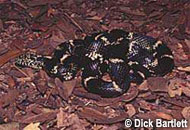Description:
The eastern kingsnake has a distinct chainlike patter of white- or cream-colored bands, usually 15 to 44 on a dark brown or black background. Cages should be escape proof, complete with water and hiding area. Kingsnakes and milk snakes must be housed separately (except during breeding season) because they are cannibalistic. Inexpensive enclosures such as plastic shoe or sweater boxes work well if there are ventilation holes drilled in the sides. Aquariums or home-made enclosures also work well if you want to display the snake. A variety of substrates may be used (aspen shavings, corn-cob-type rodent bedding or newspaper) to keep the animals clean, warm and dry. Kingsnakes will feed on just about anything. They will consume warm-blooded prey such as rodents and birds, as well as cold-blooded prey such as lizards and frogs (in addition to other snakes). Many species adapt well in captivity if kept between 80 and 85 degrees Fahrenheit, with a nighttime temperature drop of five to 10 degrees. Temperature control is important as it maintains feeding response and digestion.
Habitat:
Forests, swamps, wetlands and commonly near farms.
Range:
Southern New Jersey to West Virginia, south to north Florida and west to the Appalachians and southeastern Alabama.
Scientific Name: Lampropeltis g. getula
Species Group: kingsnake
Family: Colubridae
Size: One of the largest and heaviest-bodied of all getula, it can be from 4 to 7 feet in length
Level: beginner
Weight:
Dangerous: No



